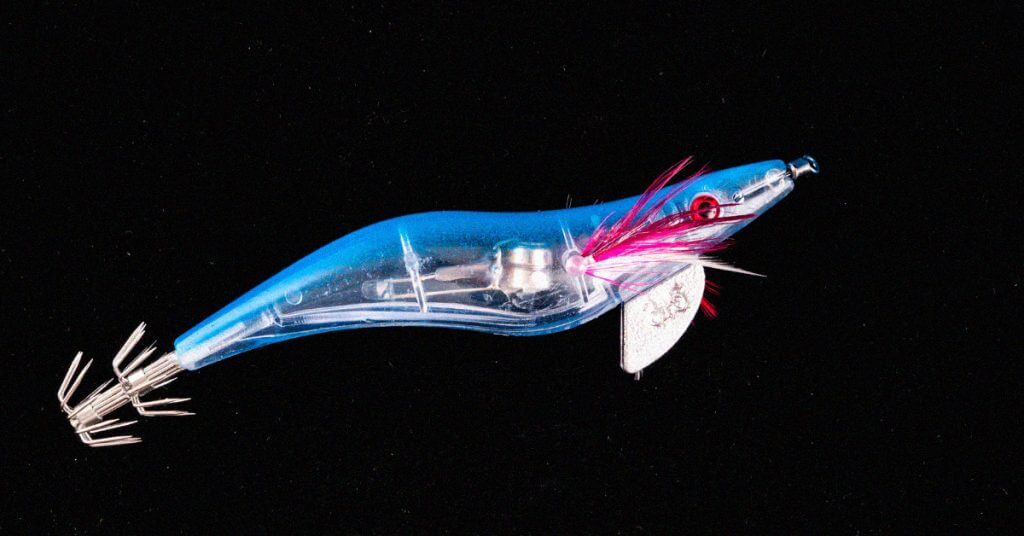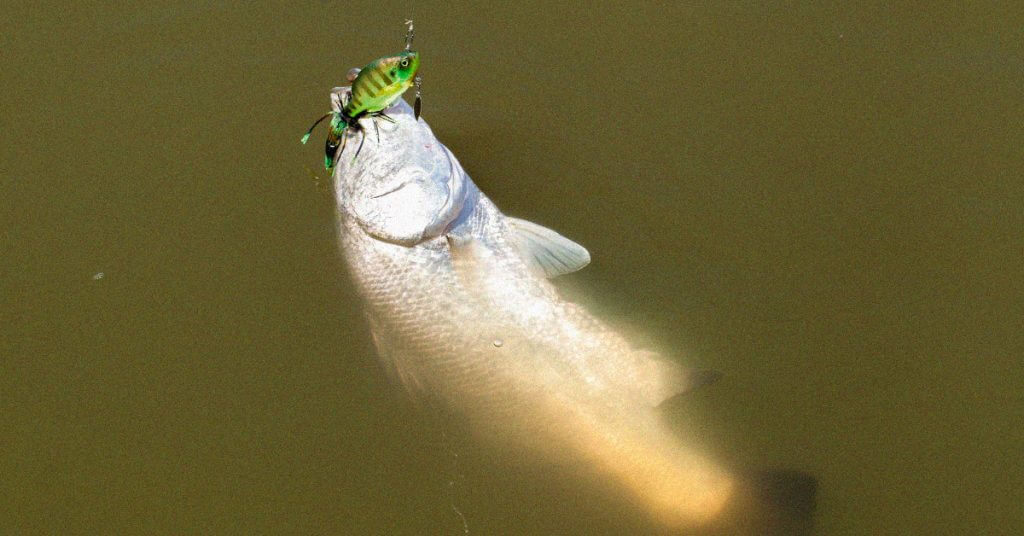Ask ten bass anglers how to catch bass in clear water, and you will likely get ten different answers.
One angler will swear by crankbaits, while another will insist Yamamato Senko worms are the way to go.
A third fisherman will attest that, in their experience, a spinnerbait is the most effective, and a fourth will swear by the Ned Rig.
One thing most will agree to, however, is that trying to catch smallmouth and largemouth bass in clear water is more challenging than trying to catch them in dirty water once you find them.
The reason is that bass already have excellent senses that can tell them where bait is located in muddy water.
In clear water, bass add great eyesight to their arsenal of ways to beat you.
If you find yourself facing water so clear you can see several feet down and, in some cases, see several feet into deep water, here are the best bass lures for clear water fishing and some bass fishing tips to help you land some hogs.
Table of Contents
5 Best Bass Lures for Clear Water

The following are the five best types of baits for fishing in water that ranges from very clear down to slightly muddy.
Swimbaits
Swimbaits bring two things to the table: Fish find their action irresistible when the bass are biting, and you can cover a lot of water using them.
It is a quick retrieval lure, although you can stagger the retrieve to let the swimbait work at different depths.
Swimbaits can be hard or soft and look like baitfish.
Because they offer a lot of action, bass see them from far off and can give chase before committing to attacking the bait.
Seeing the bait’s erratic action excites the bass and allows you to trigger a reaction bite.
Jerkbaits

Jerkbaits are hard baits that resemble small fish.
You can retrieve them in many different ways, including bringing them in fast, retrieving and pausing, and finesse-twitching them before pausing to resemble an injured minnow or baitfish.
Jerkbaits work best in colder and clearer water, making them very effective in early spring and late fall.
There are three main types of jerkbaits: Floating, sinking, and suspending.
There are also variations of each type of jerkbait.
For example, one of the most effective is a suspending jerkbait that slowly sinks when a retrieve is paused.
This action lures big bass because it resembles an injured baitfish, particularly in cooler water.
Topwaters
Topwater lures are some of the most fun to fish because a fish attacking a lure on top of the water is one of the most exciting fishing experiences an angler will witness.
There are many topwater baits, including poppers, wake baits, weedless frogs, buzzbaits, and spooks.
How you fish topwater baits depends on the environment you are fishing in.
A wake bait works well at dawn and dusk for water with a lot of clarity.
Baits with rotating propellers, frogs, and other animals work best when there is a little chop on the water.
Poppers work best when allowed to sit before retrieving them with a twitch or jerk to make a noise and produce bubbles.
Usually, topwater baits work best in warmer water when fish are actively feeding. Try a topwater on the edge of lilies, floating over rocks or structure, or along the line of an aquatic weed bed.
Jigs

Jigging for bass opens the door for several different baits and techniques.
A jig is a weighted hook with the weight molded at the top of the hook and a skirt. The line is tied directly to the hook.
Jigs can be hopped along the bottom, retrieved sporadically, or lowered to desired depths and twitched occasionally.
Jigs work year-round in any type of water on any fish.
They are extremely popular in ice fishing, but dropping a jig down around the structure and twitching it to entice a bass to go after it is about as much fun fishing as possible.
Make sure your jig heads are legal before you use them. For example, older jig heads made of lead are banned in some states and waterways.
Soft Plastic Worms
Soft plastic worms are one of, if not the most popular bait for bass.
Whether you use it as part of a Texas rig, Carolina rig, drop shot, or shaky-head rig, you will attract the attention of any bass in the area using soft plastics.
One of the most effective methods of using plastic worms is called the “wacky rig.”
A wacky rig entails using a band to secure a hook to the middle of a weightless worm or putting the hook through the middle and retrieving the rig by jerking it subtly to bend in the middle.
A “reverb” effect at either end lasts after the bait has been jerked.
Another effective strategy is to use a worm hook and just a worm and let the worm go with the current or slowly sink to the bottom.
Twitching your rod tip produces a slight wiggle that makes the worm look alive.
2 Killer Rigs for Glass Bass
The following are two rigs that work very well for water that ranges from mostly clear to very clear.
Drop Shot Rig
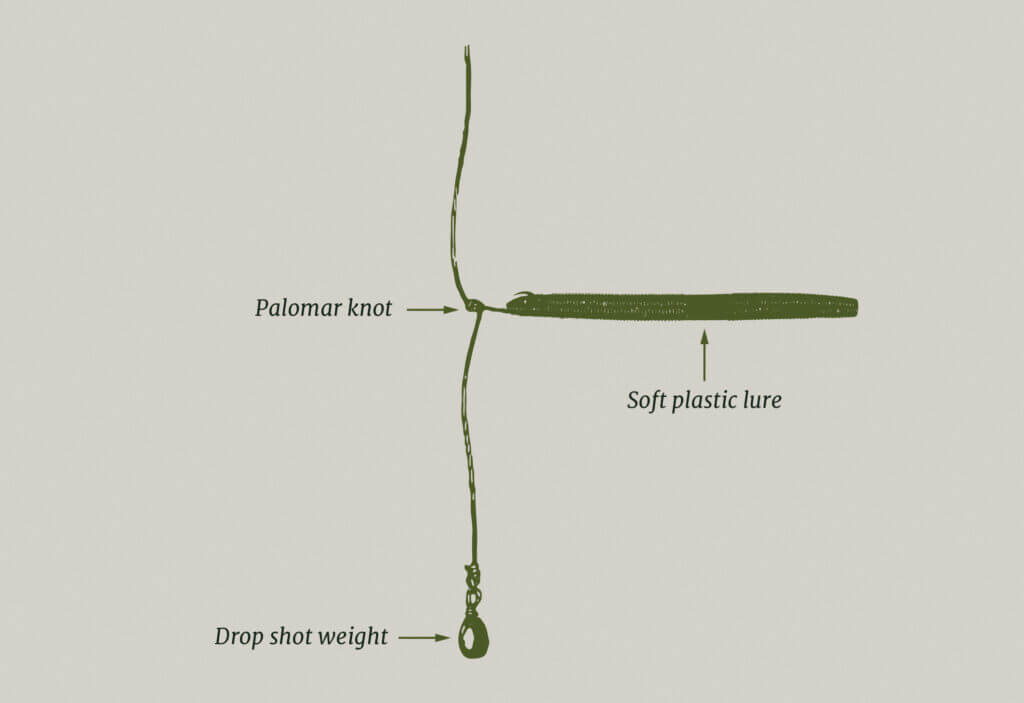
The drop shot rig entails tying the line to a hook and leaving a trailing leader that a weight is attached to below the hook.
As a finesse rig, the drop shot is one of the most effective ways to catch bass in clear water despite being excruciatingly slow to fish.
Cast the drop shot and let it all to the bottom, then work the bait back to your position by slow pulls, twitching, and an ultra-slow retrieve.
A drop shot rig works well in water with a current and on the edge of eddies.
The bait floats above the weight and hovers above the bottom while moving.
Most fish cannot resist a drop shot fished correctly.
Drop shot rigs work really well in colder water because you can work them slowly and let them set for several minutes.
They are also effective in pre-spawn periods and the fall when the water starts cooling.
Shaky Head Rig
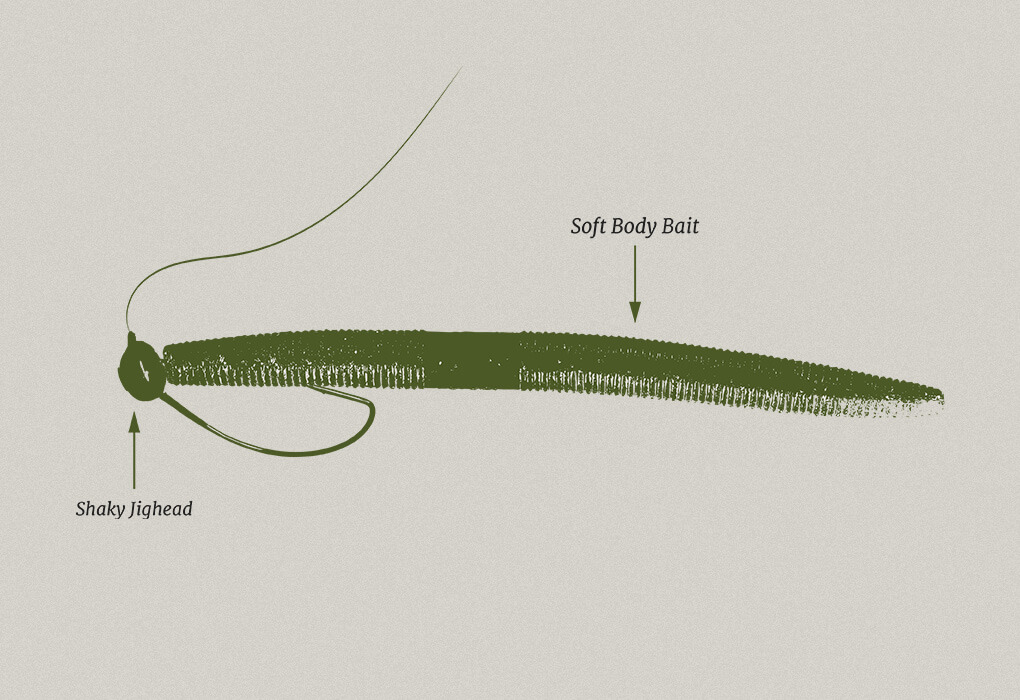
The shaky head rig is a plastic bait combined with a small jig head that stands upright when the jig head hits the bottom of a body of water.
There are several ways to fish a shaky head.
One way is to “hop” it along the bottom, letting it sit still for up to ten seconds (except in winter when you can let it sit for as long as a few minutes between hops).
Another method is to swim it using long casts to put it past your target point.
Retrieve the bait for a few feet and pause; retrieve it for five to ten feet, pause, and so on.
When you pause, let the bait drop, but if you are in an area with a lot of snags or the bait drops below your target zone, speed up your retrieve to bring the bait back up in the water column.
A third shaky head method is to drag the bait across the bottom.
Retrieve and let the bait set for up to a minute.
Repeat that until you have brought it back in.
This approach is very effective in cold water.
Best Tips for Clear Water Bass Fishing
Using the best lures available is essential, but so is how and where you present your bait.
Here are some tips to help you overcome water clarity that is transparent or translucent.
Go for Cover
Super transparent water does not give bass many places to hide from the sun, prey, and predators.
So try fishing rocky areas, submerged structures, such as brush piles, tree trunks, artificial structures, and aquatic vegetation.
Set your trolling motor to a slow speed and run your bait along grass lines, including letting it hit bottom to stir up silt.
Bass will notice the action early and wait for the bait to come by; when it has annoyed them enough, they’ll bite.
The same holds for running weightless plastic worms or other creatures.
For example, a Ned rig and a craw will let the bass size up the bait before committing.
Try running a wacky rig alongside or above vegetation and cover.
Consider a Fluorocarbon Leader
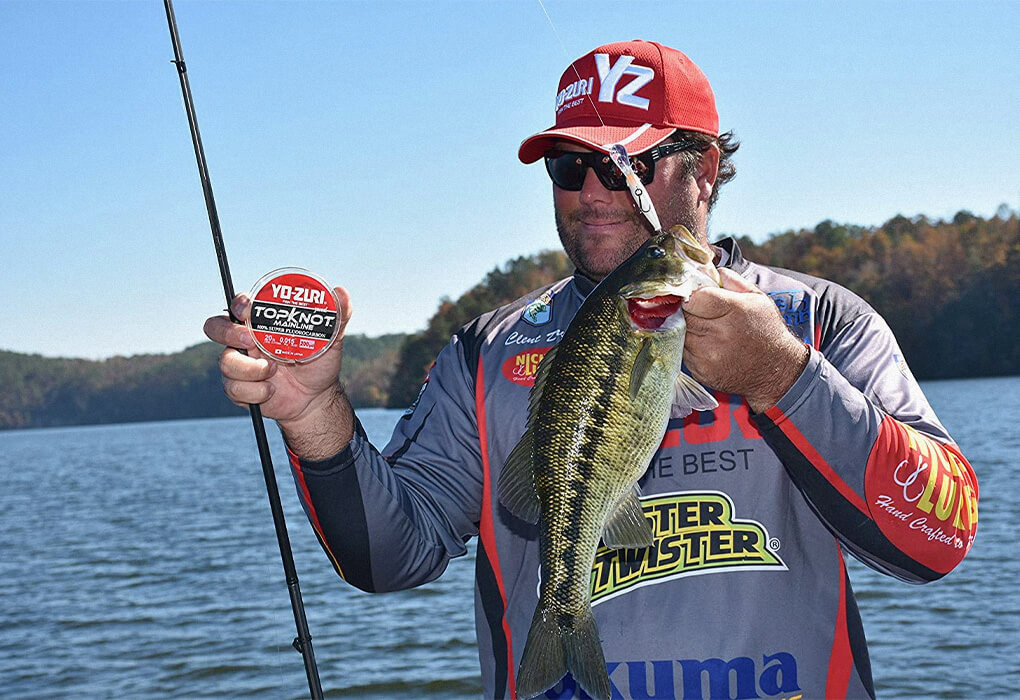
Bass have excellent eyesight and can see fishing lines.
Seeing a line can spook any fish, including walleye, trout, and bluegill.
Because of fishing pressure in most places, bass are really picky, and seeing a line attached to a lure is often a deal breaker.
To combat that, consider using a fluorocarbon leader.
Fluorocarbon is almost transparent and is very difficult to pick up in even water that is crystal clear.
The bass might see your main line, but your lure will look more natural with a leader.
Look for Shade
The warmer the water, the more bass feed; up to a point when the water temperature hits the high seventies, smallmouth head for cooler, deeper water.
Largemouth feed in warmer water, but they look for shade to hunker down under when the water gets into the mid-80s.
Clear water heats up quickly, which means finding shade becomes more important the longer you fish into the day.
When you get to the point that the bass are hunkered down, forget about poppers and other topwater baits. Tie on a jig and drop it into or next to shaded areas.
A drop shot or Texas rig along a weed line in the summer heat can prompt a bite.
Finding shade is particularly important in shallow water.
Shallow water heats up extremely quickly, and bass will leave it for deeper water unless the fish can find somewhere cooler.
A shadow from a rock, tree, or other structure can provide enough cool water to keep fish anchored without resorting to deep water.
Know Your Colors

Have you ever wondered what color lure to use in clear water?
Bass fishing in clear water requires you to present something to the bass that resembles what they would typically eat.
A typical presentation means matching your lure color as close as possible to the shad, crayfish, or type of baitfish you are mimicking.
Natural colors such as green pumpkin, pearl, white, silver, or translucent often work the best.
For example, if you are using a swimbait that mimics a minnow, you want to use a silver or silver and blue color.
This is because silver or silver on blue picks up sunlight and provides a flash bass notice and target.
Use silver blades for buzzbaits and try and match colors to the aquatic life you see around you.
For example, the best color worm for bass in clear water is green or olive, while pearl or silver works best for a fluke.
Save the chartreuse, day-glow orange, and fluorescent orange baits for another day and muddy water.
Last Cast
Matching your surroundings and presentation is vital to fishing in clear water, as is the weather, water conditions, time of year, and time of day you are fishing.
These are the best bass lures for clear water, and the tips will give you the best chance at landing big bass year-round.
Let me know in the comments if you prefer to fish in clear water or murky water!


